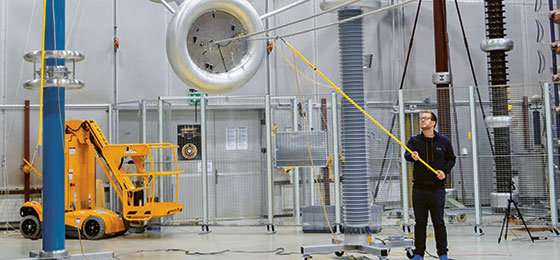Hybrid overhead lines—more power, not more power lines

Social opposition to new high-voltage lines is delaying modernisation of the power grid. Two projects of the National Research Programmes "Energy Turnaround" and "Managing Energy Consumption" have determined the optimum design of hybrid overhead lines needed to increase the capacity of the power transmission grid and, at the same time, win popular acceptance for the new technology.
Unlike conventional power lines, hybrid overhead lines combine alternating current (AC) and direct current (DC) systems on the same tower instead of two AC systems. This increases transmission capacity even though the height and width of the lines remain identical, and it avoids new construction and encroachment on the landscape. However, interference caused by the weather, contamination of the AC and DC conductor cables or the distance between cables can lead to bothersome noise and electric fields.
As part of the National Research Programme "Energy Turnaround" (NRP 70), a team of researchers at ETH Zurich investigated the optimal design of this hybrid system. "Hybrid overhead lines have two major advantages: their capacity is over 50 per cent higher and they are more likely to be accepted because you can upgrade existing high-voltage lines rather than build new ones. To minimise interference effects associated with the higher transmission capacity, such as corona humming and electric fields, we determined the best voltage and tower geometry using test lines under various real-world conditions both in the laboratory and in the field," says project lead Christian Franck, Professor at the ETH Zurich's Institute for Power Systems and High Voltage Technology.
Many advantages, but acceptance is not a given
While the new technology was being developed, the opportunities and means for achieving the necessary social acceptance were also being investigated. "Even though higher capacity without encroaching on the landscape favours the new hybrid technology, and we'll be able to significantly reduce the negative effects, we knew from the outset that hybrid overhead lines weren't going to happen without the consent of the people directly affected by them," says Franck. Which explains the collaboration with the Institute for Political Science at the University of Bern.
Isabelle Stadelmann-Steffen, Professor at the University of Bern, is investigating the social acceptance of renewable energies as part of the National Research Programme "Managing Energy Consumption" (NRP 71). The survey of roughly 1300 individuals about their attitudes towards hybrid overhead lines revealed three key findings: "First, information about any new technology must be provided proactively. Ideally, the community needs to be involved as early as possible to get across the importance of the project while providing the opportunity to include opinions and concerns in the decision-making process. Second, alternatives must be discussed, because the support for a new technology is always weighed against the alternatives. And third, the extent to which you can reduce the negative effects of a technology will naturally increase acceptance."
Better technology through interdisciplinary collaboration
The close collaboration between the researchers at ETH Zurich and the University of Bern, as well as the Swiss transmission system operator Swissgrid and distribution network and hydropower plant operators, enabled real technological advances. The ETH Zurich's engineers focused primarily on maximising transmission capacity without compromising the limit values for electromagnetic fields and noise, while findings from the research on social acceptance helped to determine an optimal balance between high capacity and the lowest possible "perceptibility."
Provided by Swiss National Science Foundation



















